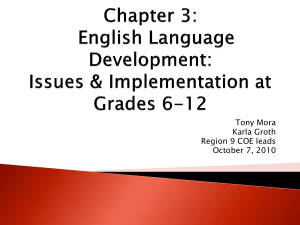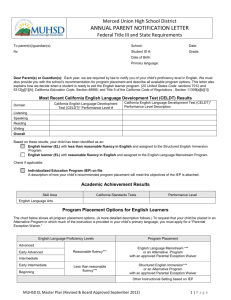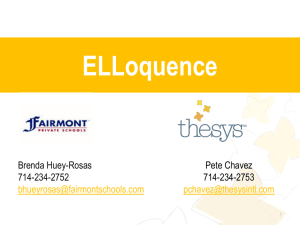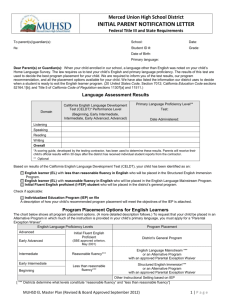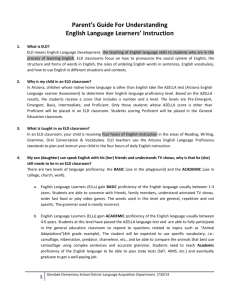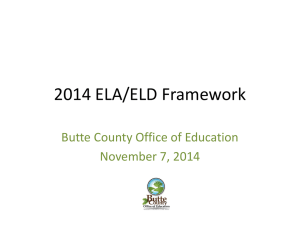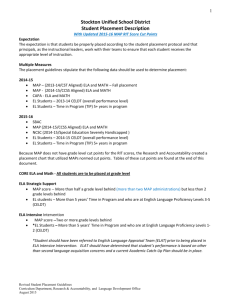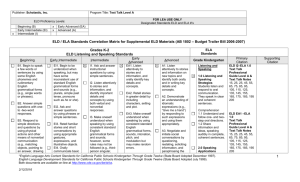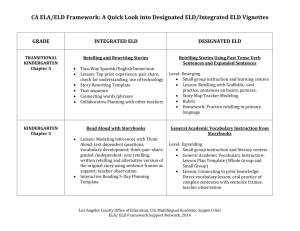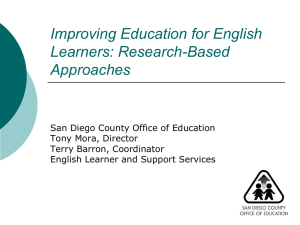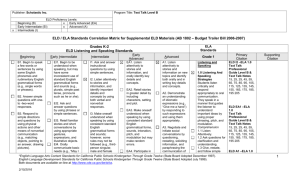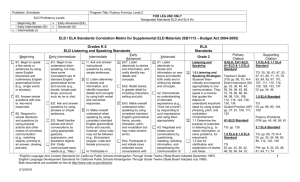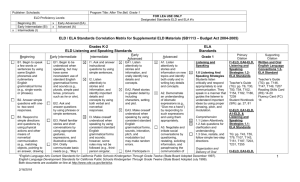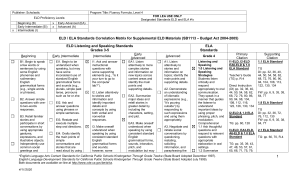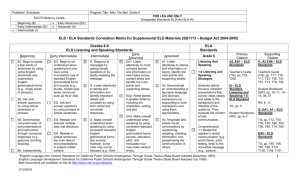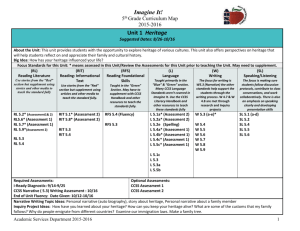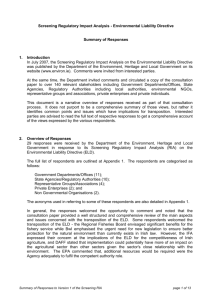Eye on the ELL in California`s System of Standards
advertisement
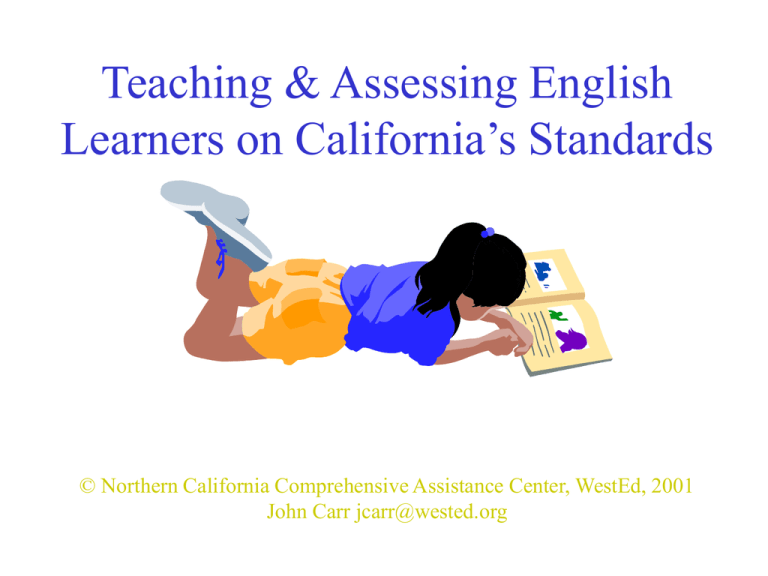
Teaching & Assessing English Learners on California’s Standards © Northern California Comprehensive Assistance Center, WestEd, 2001 John Carr jcarr@wested.org Reading Standards ELA ELD • Word Analysis, • Word Analysis Fluency, & • Fluency & Systematic Systematic Vocabulary Vocabulary Development Development • Comprehension • Comprehension • Literary Response & Analysis • Literary Response & Analysis Writing Standards ELA ELD • Strategies • Applications • Written (& Oral) English Language Conventions • Strategies & Applications • Conventions A Map for Teaching and Assessing California’s ELD and ELA Standards for English Learners www.wested.org/cc/html/carr.htm Level B ELD Standards 3–5 EI Orally identify the basic sequence of written text using simple sentences. EA Identify some significant structural (organizational) patterns in text, such as sequence/chronological order, and cause/effect. A Identify significant structural (organizational) patterns in text, such as compare/contrast, cause/effect, and sequence/chronological order. EI Orally identify examples of fact/opinion in familiar texts read to them. I EA 3 Identify the basic sequence of events in stories read to them, using key words or pictures. ELA Standards 4 2.6 Distinguish between cause and effect and between fact and opinion in expository text. Read and orally identify examples of fact/opinion and cause/effect in literature and content area texts. Distinguish between explicit examples of fact, opinions, inference, and cause/effect in texts. A Distinguish between fact/opinion, inference, and cause/effect in text. B Understand and follow simple one-step directions for classroom or work-related activities. EI Understand and follow simple two-step directions of classroom or work-related activities. I Understand and follow some multi-step directions for classroom-related activities. 5 2.1 Identify structural patterns 2.2 Analyze text that is found in informational text organized in sequential or chronological order. (e.g., compare and contrast, cause and effect, sequential or chronological order, proposition and support) to strengthen comprehension. 2.7 Follow simple multiplestep written instructions (e.g., how to assemble a product or play a board game). 2.7 Follow multiple-step instructions in a basic technical manual (e.g., how to use computer commands or video games). 2.5 Distinguish facts, supported inferences, and opinions in text. English Language Proficiency Levels • • • • • Beginning (B) Early Intermediate (EI) Intermediate (I) Early Advanced (EA) Advanced (A) At any given proficiency level, a student can perform the specified task independently and automatically English Language Proficiency Levels • You will divided into groups of 5, as indicated by the Roman numeral on your slip of paper. • You will start in your expert group, e.g. beginning, early intermediate, etc. • Each group member will be assigned one proficiency level to become an expert at that level. • Using the ELD Standards, work with the expert group to provide examples of skills a student at your level can do independently and automatically. • Your expert group should have examples of skills for each Language Area; Listening / Speaking, Reading, and Writing. • Individually, record the skills on the mini-poster paper, by proficiency level AND language area, to teach to your home group (I., II., III., IV., V., VI.) English Language Proficiency Levels • • • • • Beginning (B) Early Intermediate (EI) Intermediate (I) Early Advanced (EA) Advanced (A) Instruction should be targeted to the skill level ABOVE current abilities Standards-Based Assessment • Measures content standard(s) • Yields performance levels Mainstream Classroom in a Standards-Based District • Reasonably Fluent ELs learn grade level content standards with ELD/SDAIE • Instruction primarily on ELA standards assess ELA standards • Instruction primarily on ELD standards assess ELD standards Reasonable Fluency is ... ELL students at “reasonable fluency” receive instruction and assessment on grade level content standards How do you define reasonable fluency? – Ready to learn ELA standards? – Ready to learn content area standards? – (does it depend on grade level?) A Good Assessment • Is accurate for every student (to what extent is this possible?) • is aligned to standards • provides useful feedback to teachers to guide instruction – and to students to guide learning Equitable Assessment for All Students • Same Content Standards • Same Performance Standards • Modifications & Alternative Assessments for equal opportunity Equity = diverse opportunities • To learn: diverse teaching strategies to meet students’ diverse learning needs & interests • To be assessed: diverse assessment strategies to meet students’ performance needs & interests • Same Content & Performance Standards with diverse strategies to meet diverse student needs Challenges to Equitable Assessment of EL Students • Comprehending the Instructions • Producing an Answer • Understanding the Culture Production Challenges: Modify the Procedures • Show samples of responses, clarify form of desired response • Provide extra time, breaks, several sessions • Use editing process to support writing for essays/reports Production Challenges: Modify the Assessment • Allow illustrations to support text; provide graphic organizers • Shorten response length; segment • Correct language convention errors, respectfully, privately, and in a focused manner. • Provide word bank • Allow oral responses Mixed Classroom (Native English speakers and English Learners) 1 Lesson + 1 Assessment ELD Standards Content Standards-Based Instruction TRADITIONAL STANDARDS-BASED • Select a topic from the curriculum • Design instructional activities • Design and give an assessment • Give grade/feedback • Move onto a new topic • Select standard(s) • Design an assessment to show mastery • Plan diverse learning activities • Plan diverse teaching strategies • Use data for feedback: move on or re-teach Adapted from Western Assessment Collaborative at WestEd 1. Standards inform Assessment 5b. If students don’t experience success and understand the concepts, the teacher Re-teaches and modifies instruction based on Assessment results 2. Assessment informs Instructional practices 5a. Students experience Learning and transition to the next level in their academic career 3. Students engage in Learning what they need to know and be able to do 4. Students Demonstrate what they know and can do How will you use the ELD Standards in your content classrooms? • Instructional Planning – Where do the ELD Standards “fit” into your curriculum throughout the year? – Are you covering ELD Standards in all the language areas? • Individual Students – Map their current abilities and target instruction one level above Student Profile English Proficiency Levels Listening / Speaking Literary Response & Analysis Reading Word Analysis Writing Strategies & Applications Reading Fluency & Systematic Vocabulary Development Writing Conventions Reading Comprehension ELD Standards: Listening / Speaking • • • • • • • • • Follow Directions Listen Attentively Speak to be Understood Vary Ways of Speaking Use Figurative Language Participate in Social Conversations Identify Media Messages Ask and Answer Questions Deliver Oral Presentations ELD Standards • In content area groups, read through the each language area of the ELD Standards • Try to match the ELD Standard to a Content Standard, curriculum area, or activity that you cover / do in your content classroom • Share some of your “matches” with the class


